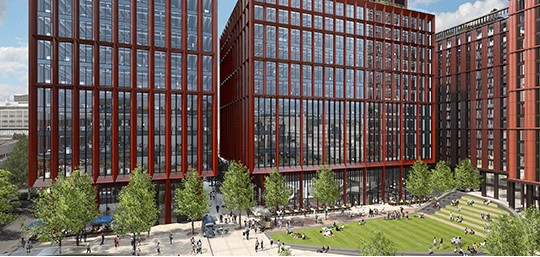The UK's second Tech City
Manchester has long been at the forefront of new media in the UK and the recent Tech Nation 2017 report estimated that the City currently supports 62,653 digital jobs creating an output of £2.8 billinn per annum.
The City's Tech infrastructure is broad-based with strong higher education, high levels of graduate retention and a good mix of accelerators and funding organisations. This will be further enhanced by the opening of Mi-IDEA and the Sir Henry Royce Institute for Advanced Materials in 2019.
The Manchester office market has seen more TMT take-up in the last 17 years than any other city outside London, and we expect that is dominance will continue.
Key growth areas for the future will include advanced materials, cyber security and digital post-production.
The biggest challenge for the City will be providing suitable office space for companies in these sectors. While we expect the big brands to be well catered for, more flexible and affordable office space is needed.
Serviced office space to proliferate
With serviced office operators taking nearly 850,000 sq ft of space in London in the first half of 2017 alone there can be no doubt that this is a booming sector.
Manchester, as one of the UK's most diverse regional economies, is an obvious second step for operators who are reaching saturation in London. While the differential between market and serviced office rents may be less wide in Manchester than in London, the large supply of second-hand office space in Manchester could present an interesting opportunity for those operators who are well capitalised enough to buy their own buildings.
This will remove the variability from their base cost, and enable them to better flex their pricing to fit demand in future.
However, the majority of serviced operator demand in Manchester will still be on a leasehold basis, and we expect to see a wider variety of offers emerging in the near future. These will cater to both start-ups and established business in existing and emerging locations.
Tight core and emergent fringes
Manchester remains one of the few UK cities that we believe offers a credible northshoring story around wage and property cost savings combined with a large and diverse labour force.
In movers from London and elsewhere will continue to be drawn to the best buildings in established locations, and this will keep voids low and drive rents upwards.
This will present a challenge for local businesses who are looking to upgrade their office space, and we expect to see more tenant demand being pushed out to the City's northern, southern and western fringes.
The rising popularity for refurbished space will mean that a lot of property that hitherto might have been targeted for change of use stays in office uses. This in turn will support a resurgent retail and leisure offer and lead to locations that were previously viewed as 'fringe' becoming 'future core'.
Our top picks for the future include the Oxford Road, Irwell Corridor and Ancoats areas.
.jpg)
.jpg)

.jpg)
.jpg)
.jpg)